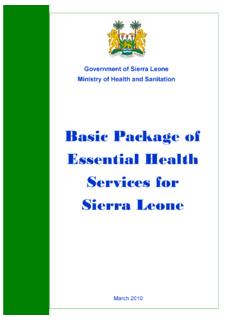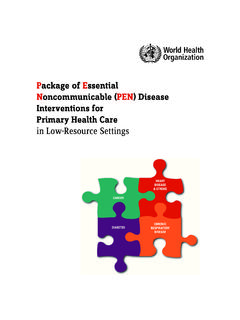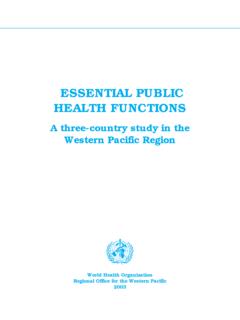Transcription of World Health Organization Model List of Essential In Vitro ...
1 World Health Organization Model List of Essential In Vitro Diagnostics First edition (2018) 16 May 2018 1 Table of contents Acronyms .. 2 Preface .. 3 List of Essential In Vitro Diagnostics (EDL) .. 10 I List of Essential In Vitro Diagnostics (EDL): For primary Health care .. 10 General IVDs for primary Health care .. 10 Disease-specific IVDs for primary Health care .. 12 II List of Essential In Vitro Diagnostics (EDL): For Health care facilities with clinical laboratories 16 General IVDs for Health care facilities with clinical laboratories .. 16 Disease-specific IVDs for Health care facilities with clinical laboratories .. 19 2 Acronyms ALT alanine aminotransferase AMR antimicrobial resistance AST aspartate aminotransferase BMP basic metabolic panel BUN blood urea nitrogen CBC complete blood count CLIA chemiluminescence immunoassay CRP C-reactive protein CSF cerebrospinal fluid CVD cardiovascular disease DST drug susceptibility testing ECL electrochemiluminescence EDL World Health Organization Model List of Essential In Vitro Diagnostics eGFR estimated glomerular filtration rate EIA enzyme immunoassay ELISA enzyme linked immunosorbent assay EML World Health Organization Model List of Essential Medicines EPTB extrapulmonary tuberculosis GPW WHO General Programme of Work Hb haemoglobin HbA1c haemoglobin A1c hCG human chorionic gonadotropin Ht haematocrit HTLV human T-lymphotropic virus
2 IGRA interferon gamma release assay INR international normalized ratio IVDs in Vitro diagnostics LAMP loop mediated isothermal amplification LPA line probe assay NAT nucleic acid test NCDs noncommunicable diseases PQ WHO Prequalification PT prothrombin time RBC red blood cell count RDT rapid diagnostic test SAGE-IVD Strategic Advisory Group of Experts on In Vitro Diagnostics TB Mycobacterium tuberculosis TST tuberculin skin test UTI urinary tract infection VHF viral haemorrhagic fever WBC white blood cell count WHO World Health Organization 3 Preface Introduction The World Health Organization (WHO) published the first edition of the Model List of Essential In Vitro Diagnostics (EDL) in May 2018, in recognition that IVDs are an Essential component to advance universal Health coverage, address Health emergencies, and promote healthier populations, which are the three strategic priorities of the WHO Thirteenth General Programme of Work (2019 2023) (GPW).
3 The EDL is also intended to complement the WHO Model List of Essential Medicines (EML) and enhance its impact. Objectives of the Model List of Essential In Vitro Diagnostics (EDL) The EDL outlines a group of IVDs that are recommended by WHO for use at various levels of a tiered national Health care system. The EDL is not intended to be prescriptive with respect to the IVDs listed or the levels at which such IVDs can/should be used; rather country programmes should make the ultimate decisions about which IVDs are selected and where they are implemented, based on national or regional burden of disease, unmet needs and priorities. It is expected that the EDL will provide guidance and serve as a reference to Member States (including ministries of Health , programme managers, end users such as laboratory managers, procurement officers and reimbursement systems), who are developing and/or updating lists of national Essential IVDs for defining universal Health coverage interventions, as well as selecting and implementing such IVDs.
4 It will also inform United Nations agencies and nongovernmental organizations that support selection, procurement, supply, donations or provision of IVDs. Finally, it will inform and guide the medical technology private sector on IVD priorities and the IVDs needed to address global Health issues. While the EDL provides a list of important tests required at various levels of the Health care system, it is important to note that the EDL itself cannot have an impact without an integrated, connected, tiered laboratory system, with adequate human resources, training, laboratory infrastructure, and regulatory/quality assurance systems. Impact also requires Member States to adopt and adapt the EDL and develop national and regional EDLs, as well as to implement the selection and supply mechanisms necessary to ensure access to the IVDs.
5 Scope of the first edition of the EDL Based on the EDL selection criteria described below, the EDL consists: A group of general laboratory tests that can be used for routine patient care as well as for the detection and diagnosis of a wide array of disease conditions communicable and NCDs. These IVDs are grouped by test discipline ( clinical chemistry, serology, haematology, microbiology and mycology) and specific test type ( bilirubin, complete blood count, etc.). IVDs designed for the detection, diagnosis and monitoring of each of the following WHO key disease areas: HIV, TB, malaria, HBV/HCV, and HPV and syphilis. These IVDs are grouped by disease area and analyte tested. 4 The EDL does not list specific test brands, but rather consists of IVDs described according to their biological targets.
6 Where specific products in categories of tests contained in the EDL have been prequalified by WHO or are recommended by a WHO disease programme, a link is provided to that information, which is updated regularly. EDL content and format For each specific test listed in the first edition of the EDL, the following are described: Test purpose: Purpose for which the test can be utilized. Assay format: The assay format or formats in which the test is generally available, enzyme immunoassay, nucleic acid testing. Specimen type: The types of specimens that can be used for the test. Facility level: The level of the tiered Health care delivery system for which the test is suggested, as described below. Link to WHO guidance: If there is existing WHO guidance available on the test or category of testing, a link is provided to the appropriate location on the WHO website.
7 WHO PQ or endorsed products: For each specific test for which there are brands of products either prequalified by WHO or otherwise endorsed by WHO, a link is provided. The EDL is presented by Health care facility level in two tiers: I IVDs for Primary Health care; II IVDs for Health care facilities with clinical laboratories. Recommended use of the EDL In order to effectively use the EDL and adapt it to national needs, WHO recognizes that Member States will need to consider a variety of factors. These include, among others: local demographics and burden of disease; local disease elimination priorities; local availability of treatments; training and experience of available personnel; local unmet needs and testing gaps; supply chain and transport links; quality assurance capacity; financial resources; information technology capabilities; and environmental factors.
8 To that end, information that supports the selection and use of IVDs on the EDL, such as relevant WHO clinical guidelines, selected systematic reviews, key references, lists of prequalified IVDs and IVDs recommended by WHO disease control departments, as well as other relevant resources on quality assurance, basic techniques, procurement and maintenance guidance, will be collated and maintained on the WHO website on an IVD-specific webpage linked to the EDL. The EDL should not be used in isolation, but in the context of the scope of testing services that meet the clinical needs and expectations in each country through their own particular laboratory networks. An illustrative example of a tiered Health care delivery and laboratory network in resource-limited countries is set out in Figure 1.
9 The pyramid of testing reflects that there are generally a large number of primary care facilities and that they serve most patients directly for primary care needs. As one goes up the levels of the system, there are a smaller number of 5 centralized facilities serving fewer patients directly. In the case of national reference laboratories and some provincial laboratories, they may not serve patients directly or they may offer a broad set of specialist consultative services, and act more as referral centres for quality assurance and training or for conducting complex tests (either using samples drawn at facilities lower in the system and transported or by receiving patients referred directly from other facilities). Figure 1.
10 The types of testing that are appropriate at each tier will be country-specific and will include, among others, factors such as access to electricity, reagent grade water, phlebotomy and specialized human For purposes of the first edition of the EDL and to simplify its presentation and use, IVDs are listed for two tiers: primary care settings where no or minimal laboratories are available (Level I in Figure 1) or for laboratory-based facilities (Levels II, III, and IV in Figure 1). Process of development of the first edition of the EDL In March 2017, the WHO Expert Committee on Selection and Use of Essential Medicines recommended that an EDL be developed. In support of that recommendation, WHO created an EDL Secretariat, which drafted the first edition of the EDL in consultation with colleagues in the various WHO disease programmes.


















